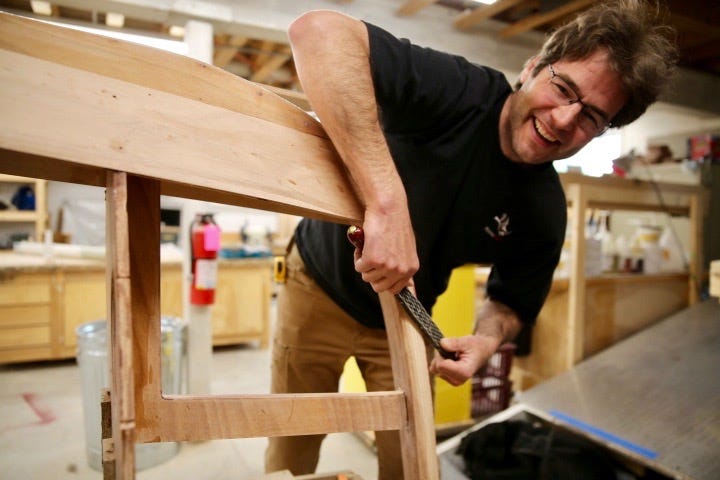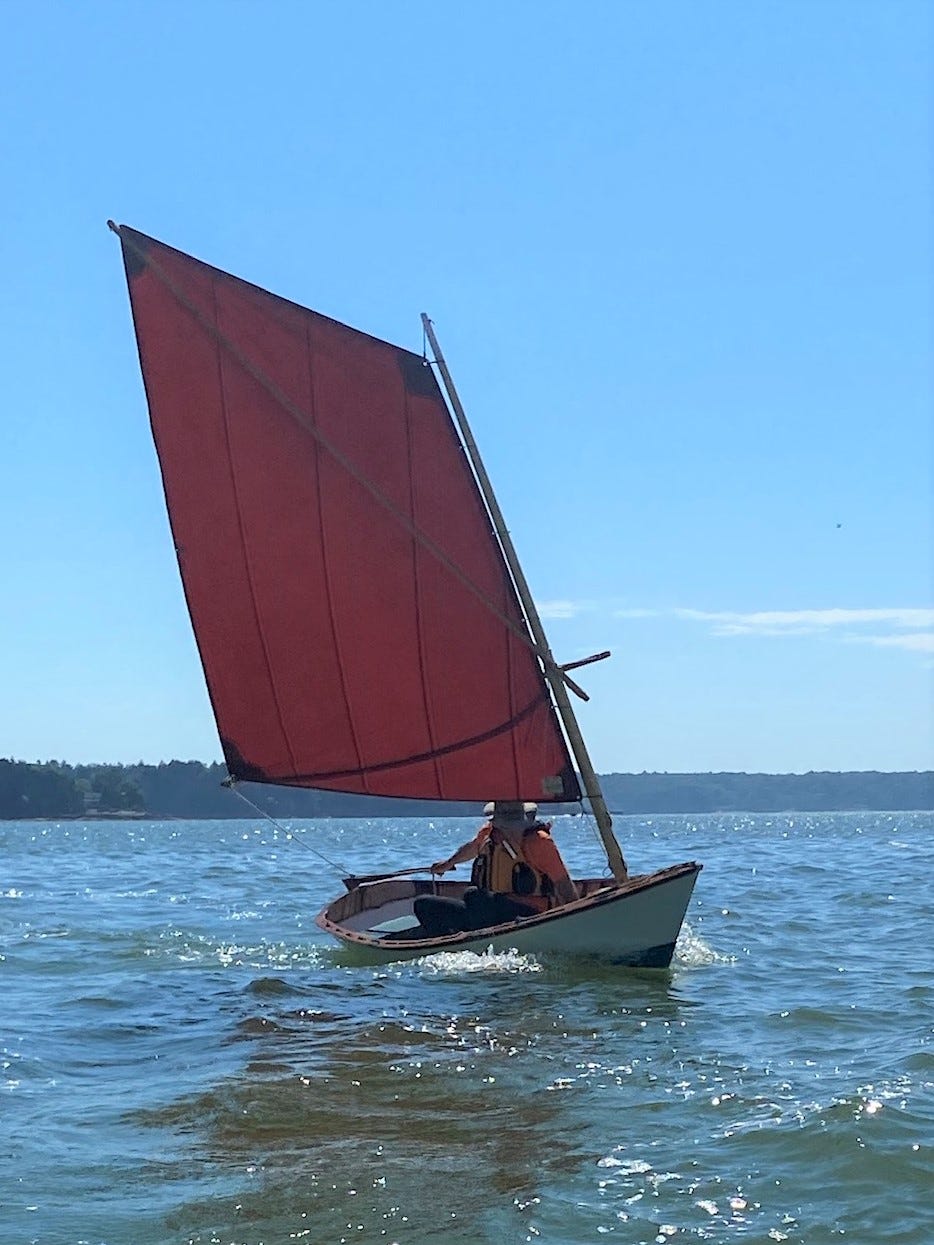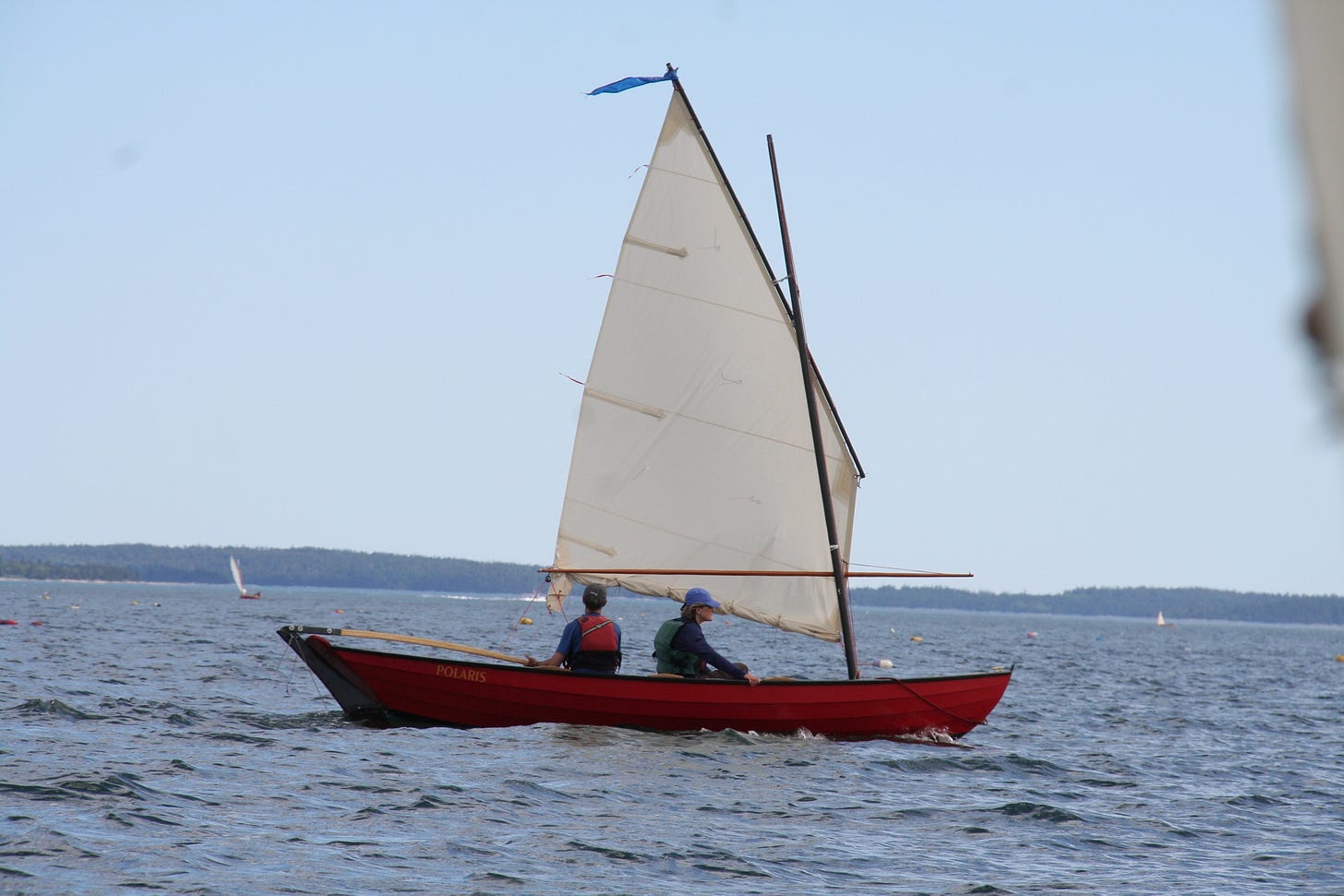We caught up with well-known small-boat-builder, kit-designer and instructor, Clint Chase, and asked him about his favorite designs, his favorite cruising grounds, and if he agrees only a fool would paint a boat black…
What was your path into boats and boat building? It started with fixing up old, classic plastic boats—a Pearson Triton and a Tartan 30 and then needing a tender for them. An old friend cut me a boat kit for a scaled down pram that I built as practice then I built my first boat, a Shellback Dinghy. I was trying to be a good science teacher at the time and wasn’t loving the classroom. This is around the early-mid 00’s. Then I decided to go for it, applied to The Landing School in Arundel, Maine, and took a year to learn how to build there. I got a job after that year working with a youth boatbuilding program in Portland ME called Compass Project and combined my teaching and boatbuilding through that job. I actually learned a lot about boat building but I wanted to learn design. Took a week long class at Woodenboat with Paul Gartside in 2007 and I was hooked. I have designed more than built boats since then!
We understand you have a background in meteorology and geology. Do you see your interest in sailing and being on the water as related to these studies of the natural world? Yes definitely. After college I had a job on Mt Washington Observatory for a short year and studied geology in school. When I am out sailing in open water I’m looking at and experiencing meteorology like I want to: observing, tracking, and noticing patterns. Being on the water, big open spaces, reminds me of being on the mountain. The inshore, scattered islands in Maine are a geology dream. I still geek out around rocks!
When did you start Chase Small Craft and what was your first offering? Chase Small Craft technically started in early 2016 when I got into my current shop space—it was much smaller then. I have since grown into the roughly 3,000 sq feet there that I occupy. In 2010 I did a short stint as Clint Chase Boatbuilder before getting recruited to teach for a couple years at the Landing School. Then I spent a year in retail at Hamilton Marine and I focused on what I would do next: no boat building, just kits was the goal. The first kit, I think was the Drake 17—in fact the first kit was built beautifully in Port Angeles by now friend Kent Fosnes. Shortly after that I took the shop patterns for the Echo Bay Dory Skiff and digitized them.
Which boat designers have you worked with? Roger Long, a N.A. retired now out of South Portland, Maine. Bruce Elfstrom who penned the original lines for the KDI. Eric Risch, a friend who drew the original Echo Bay Dory Skiff lines in the 80s. Francois Vivier was an important connection for me early on thanks to Chuck Leinweber. I have collaborated with Michael Storer in Goat Island Skiff yawl modifications. I collaborate currently with David Cockey, an engineer friend, and David Wyman, N.A. here in Maine. I obviously enjoy the collaboration and learn a great deal through them.
Who are some other designers (living or deceased?) you especially admire?Joel White was the first one I studied and Paul Gartside of course because I learned much from him in the week class at WoodenBoat. I studied Iain Oughtred a great deal as well, Vivier of course, and of course all the small craft John Gardner measured and documented.
What do you tell someone who asks you whether they should build or just buy a boat? You don’t build a boat to save money and certainly not time. It is about the process of understanding and doing and making something new that most or almost all my customers find rewarding, it seems. The actual result is a benefit—the boat itself—but I think the project and the routines around integrating that work into their lives (many of them retired) are what they think most fondly about. If you want to learn to use, sail, explore the coast in a boat—the boating itself—find something used to get started—but you will never regret building your own. The nice thing about building your own is that it can really be chosen and built to fit your lifestyle. The way the boat is set-up and rigged and adapted is what makes the link between using the boat and building your own. Get something used to hit the water and while you are doing that I tell people to get a small kit that they can pick away at in their garage or basement so they can satisfy that urge. These kits teach a great deal about boatbuilding and working with your hands as well as problem solving and figuring things out.
Do you think the time saved building from a CNC kit justifies their cost? What are the other advantages? I think chopping out 25% of the time to build justifies some of the cost. But then there is the certainty of getting the finest materials, in the right quantities, and with good instructions that adds to the justification. The time saved not having to figure out what these bills of materials need to be and then finding and sourcing those items alone may be worth the cost of the kit! People want their boat to come out right and the kit adds to their feeling of confidence that they are starting out right. When someone is stuck on even the smallest point, they know they can text me, call or email. That lifeline is huge for people—knowing that the designer, builder and kitter of these boats is available to help them is a massive plus for people.
What’s one fiberglass production boat you really like? Well I owned a Tartan 30 for years and that is a neat boat!
Where are your favorite small-boat cruising grounds and why? Maine Coast of course. The southern, midcoast, and downeast sections are all different and each one offers a lifetime of experiences. The amount of camp m-cruising, island picnics, and beach combing here is endless.
How do you see the small-boat and boatbuilding world changing? Anything new or revolutionary on the horizon? Or how about a boat type or purpose gaining popularity? The integration of electric motors into the boats is the next thing. I think the ability to add a small electric motor to a number of designs, and designing new boats around them, means they can be made more accessible to more folks so they can enjoy these small boats further into the golden years of their life. In particular the sail-and-oar boats become much easier to use for folks knowing they can turn the thrust on even a little bit to help them get back home.
Which of your kits makes the best beachcruiser or sail-and-oar shallow-water explorer? I think the Calendar Islands Yawl 16 is that boat. It is light, the mizzen makes it a real cruiser, the volume inside is great for two and gear, the boat is light and two can roll it up and down a beach on rollers, and it will delight the sailor and make a rower happy at the same time. It is very versatile—choose your waters—and add sails and oars. The CIY has a narrow flat bottom for beaching and I use a graphite-epoxy coating that creates a “frying pan” bottom which makes it super beachable. With the daggerboard or centerboard up, she can skim over shoals.
OK, here are few “Agree” or “Disagree” questions for fun:
Nathanael G. Herreshoff said: “There are only two colors to paint a boat, black or white, and only a fool would paint a boat black.”
Agree.
Olin Stephens said: “I consider it a pleasure to sail a boat but I don't sail a boat for pleasure, if you get the distinction.”
I think I get it…I row for pleasure, personally
Lin and Larry Pardey said: “If you can’t repair it, maybe it shouldn’t be on board.”
Agree!
What’s your latest Chase Small Craft offering and what do you have on the drawing board? Currently we’re designing a Calendar Islands 20 for WoodenBoat School to use in their fleet for their new sail-and-oar boating classes. That boat, if it all works out, will have a cuddy cabin version as well. The idea is that it will be a step down in scale and cost from the Vivier Jewell. The other items on the drawing board is a new 16’ fast rowboat called the Monument River Wherry, a St Lawrence River SKiff by Andrew Steever, and a new Dory called the Nautilus Dory that will have a sail and a row version (the rower is being prototyped now). There are more on my site, but those are the priorities. Just launched is a new 13.5’ kayak design which will be released this Fall.
New kit released are: the Calico skiff, a 9.5’ motor-sail-row cutie, the Points East Pram 8’, and the Calendar Islands 18 which has been out for a while now. By Vivier, I now offer Kerisper a 16’ motorboat and Lilou 2 a very cool sailboat that has an inboard motorwell.
Where can readers learn more about your company and projects? www.chasesmallcraft.com has it all. I have a YouTube page and Instagram! In the Fall I have a messabout for CSC boats and in the spring an open house. Other in person events are the WoodenBoat Show and I hope to start coming out to the PT Festival every other year again starting in 2024. I have a slew of classes that I teach on the website as well. I would love to get more going out on the West Coast. •SCA•









Couldn't agree more on the 16' Calendar Islands Yawl. A lovely and capable boat. Clint's a great guy, but his designs might be even better :)
Scott from Duckworks Boat Builders Supply
I built a KDI in 2019 from Clint’s kit. It was my first build, and being a double ender, especially challenging to plank. Clint was available to answer my many questions via text, email, and phone. I sailed that for 3 years out of Santa Barbara harbor. It is a good design, lightweight and nimble, but ultimately a bit wet and small for the open Pacific swell and chop. I’ve since sold it and am completing a build of Francois Vivier’s Stir-Ven 19. Clint supplied this kit as well. This is a much more substantial boat with water ballast and space for up to 5 crew. Eric Bridgford of Carpinteria Dory Company and I are collaborating on this build. Expect to launch in August.